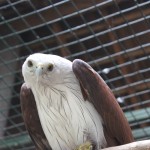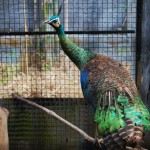PRIMATES
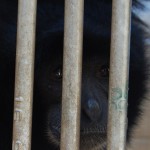 Siamang (Symphalangus syndactylus)
Siamang (Symphalangus syndactylus)
Siamang is a tailless, arboreal lesser ape. It is native to Sumatra in Indonesia, Peninsular Malaysia and a small area of Southern Thailand. Two young siamangs came to the rescue centre on December 9, 2005. They are both male and around 8 years old now. At this age in the wild they would leave their family group. Our siamangs will hopefully be transferred to a rehabilitation facility at Wey Kambas National Park in Sumatra, and eventually released back to the wild.
.
Javan lutung (Trachypithecus auratus)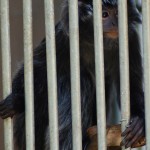
Our female Javan lutung was rescued in 2010. This species is endemic to Indonesia, and can be found on the islands of Java, Bali and Lombok. Lutungs, also called langurs or leaf monkeys, are social animals, living in groups of around seven individuals, with one or two adult males in the group. Javan lutung is a leaf-eater with a specialised stomach for plant matter digestion. It also consumes fruit, flowers, flower buds, and insect larvae. We are working on finding a suitable place for this lovely lutung.
.
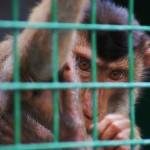 Zuid-pig-tailed Makaken (Macaca nemestrina)
Zuid-pig-tailed Makaken (Macaca nemestrina)
Southern pig-tailed macaque has a short tail that is carried half-erect and somewhat resembles a pig’s, hence its name. This species is found in Brunei, Indonesië (Bangka, Kalimantan Borneo, and Sumatra), Maleisië (Peninsula Malaysia and Sabah and Sarawak Borneo), evenals het zuiden van het schiereiland Thailand. We hebben drie Zuid-pig makaken, twee mannetjes en een vrouwtje bij BWRC. These macaques will hopefully be transferred to Ciapus Primate Center in Java, which has a focus on their rehabilitation.
.
Javan slow loris (Nycticebus javanicus)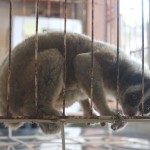
Our newest primate arrival was a confiscated Javan slow loris in June 2012. It seems to be in good health and is staying in quarantine. After that it will be transferred to a newly built enclosure. Slow lorises are nocturnal and arboreal. They feed on sap and floral florescence as well as on gum and insects.
.
BIRDS
We have almost 20 species of birds at BWRC. Some have broken wings or are unwilling to fly due to long confinement in small cages. Some of the birds are in the process of rehabilitation, and can eventually be released in Bali. Others are waiting to be transferred to centres at their place of origin.
Grey-headed fish eagle (Ichthyopaga ichthyaetus)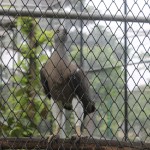
Grey-headed fish eagle is a bird of prey found in Southern Asia from India and Sri Lanka to Southeast Asia. It feeds primarily on fish, but it will also take other prey, including reptiles. The eagle at BWRC is now in a rehabilitation cage and is flying and hunting very well. Er dient te worden overgebracht naar Sumatra of Kalimantan voor een vrijval als de soort is momenteel niet in Bali aanwezig.
.
White-bellied sea eagle (Haliaeetus leucogaster)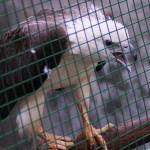
Wit-doen zwellen zeearend is ook te vinden uit India en Sri Lanka door Zuidoost-Azië naar Australië. Het leeft in de buurt van kusten en grote waterwegen, en is een opportunistische feeder. De adelaar bij BWRC niet in staat is om te vliegen als gevolg van een onbekende oorzaak en kan niet worden hersteld voordat we vinden van de oorzaak.
.
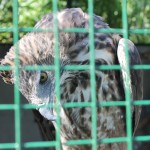 Changeable hawk-eagle (Nisaetus cirrhatus)
Changeable hawk-eagle (Nisaetus cirrhatus)
The changeable hawk-eagle is a medium-large raptor with a large range from India to Southeast Asia. Sommige ondersoorten hebben toppen terwijl anderen crestless, vandaar de naam “veranderlijk”. Sommige ondersoorten zijn ook dimorphic. This makes precise identification difficult. The eagle at BWRC does not have a crest.
.
Brahminy kite is a distinctive bird of prey with chestnut colored plumage with white head and breast, and black wing tips. It’s widely spread from India through Southeast Asia to Australia. At the moment we have two Brahminy kites at BWRC. If their rehabilitation is successful, they could be released here in Bali.
.
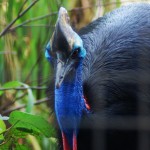 Southern cassowary (Casuarius casuarius)
Southern cassowary (Casuarius casuarius)
Southern cassowary is a large flightless bird found on the island of New Guinea (Indonesië & Papua New Guinea) and north-eastern Australia. De Zuidelijke kasuaris is een van de drie cassowary soorten in Nieuw-Guinea, , waar ze zwaar bejaagd, captured and traded close to populated areas. Cassowaries are of high cultural importance, and constitute a major food source for subsistence communities.
.
Victoria crowned pigeon (Goura victoria)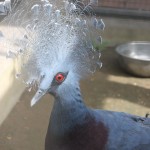
Victoria crowned pigeon is likely the largest of all pigeon species. It’s a steely bluish-grey bird with striking red eyes and a large, white tipped, fan-shaped crest of feathers on its head. The species is found only some northern parts of New Guinea(Indonesië & Papua New Guinea). The population is declining due to habitat loss and hunting for meat as well as feathers.
.
This Galliform bird used to be common and widespread through Southeast Asia but due to habitat loss and fragmentation its numbers are rapidly declining. In Indonesië, benoemt ondersoorten, Java pauw (Pm. muticus) is endemisch op het eiland Java. We have a pair of these beautiful birds at BWRC.
.
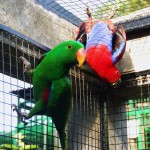 Eclectus parrot (Eclectus roratus)
Eclectus parrot (Eclectus roratus)
Eclectus parrot is native to the Solomon Islands, New Guinea, northeastern Australia as well as Sumba and the Maluku Islands of Indonesia. It is special for its extreme sexual dimorphism; they colouring between sexes is totally different, males being bright green and females bright red.
.
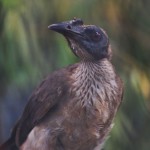 Helmeted friarbird (Philemon buceroides)
Helmeted friarbird (Philemon buceroides)
Gehelmde friarbird behoort tot een familie van honeyeaters en is afkomstig uit Indonesië, Australië, Papoea-Nieuw-Guinea en Timor-Leste. In Indonesia it can be found in the Lesser Sunda Islands (Nusa Tenggara), except in Bali. We have a group of these birds at BWRC. A habitat assessment is being done on the neighbouring island of Lombok for a possible release site.
.
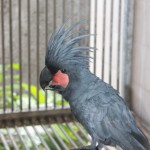 Palm cockatoo (Probosciger aterrimus)
Palm cockatoo (Probosciger aterrimus)
Palm cockatoo is yet another species found in New Guinea (Indonesië & Papua New Guinea) and northeastern Australia. The palm cockatoo is a large, smoky-grey, almost black bird with a distinctive red cheek patch. This cheek patch changes colour; it can be very pale in sick birds and bright red when the bird is very excited or alarmed.
.
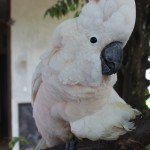 Salmon-crested cockatoo (Cacatua moluccensis)
Salmon-crested cockatoo (Cacatua moluccensis)
Salmon-crested cockatoo, also known as Moluccan cockatoo, is an endemic species to South Moluccan islands. Almost all of the remaining population is found on the island of Seram. This species has suffered from illegal bird trade as well as habitat loss.

